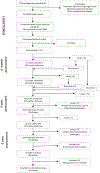Early-Life Patterns of Sugar Consumption and Dental Caries in the Permanent Teeth: A Birth Cohort Study
- PMID: 34428768
- PMCID: PMC8595800
- DOI: 10.1159/000518890
Early-Life Patterns of Sugar Consumption and Dental Caries in the Permanent Teeth: A Birth Cohort Study
Abstract
Early-life family conditions may presage caries development in childhood. The aim of this study was to evaluate associations between patterns of sugar consumption in early childhood and permanent dentition caries at age 6 years. A cohort enrolled women accessing prenatal care at public health clinics in Porto Alegre, Brazil. Sociodemographic, anthropometric, and dietary data were collected during pregnancy and 6-month, 12-month, and 3-year follow-ups. Calibrated dental examinations occurred at ages 3 and 6 years. Multivariable logistic regression analysis was performed in series to quantify associations between early-life variables and permanent dentition caries. At age 6 years, 7.9% of children (21/266) had ≥1 caries lesion on permanent teeth (first molars). In unadjusted models, gestational weight gain, sweet food introduction (age 6 months), household sugar purchases (age 3 years), and caries (age 3 years) were positively associated with permanent dentition caries (age 6 years). In multivariable models, each 1-kg increase in gestational weight gain (odds ratio [OR]: 1.08; 95% confidence interval [CI]: 1.01, 1.16) and each 1-item increase in sweet food consumption at age 6 months (OR: 1.27; 95% CI: 1.02, 1.59) remained statistically significantly associated with permanent molar caries. Findings from this cohort study suggest family and child factors that long predate the permanent dentition, including sugar-related behaviors, predict future dental status, and may inform prevention strategies.
Keywords: Child; Cohort studies; Dental caries; Diet; Life-course; Sugar.
© 2021 S. Karger AG, Basel.
Conflict of interest statement
Conflict of Interest Statement
The authors have no conflicts of interest to declare.
Figures
References
-
- Chestnutt IG, Playle R, Hutchings S, Morgan-Trimmer S, Fitzsimmons D, Aawar N, et al. Fissure Seal or Fluoride Varnish? A Randomized Trial of Relative Effectiveness. J Dent Res. 2017. July;96(7):754–61. - PubMed
-
- Doméjean S, Banerjee A, Featherstone JDB. Caries risk/susceptibility assessment: its value in minimum intervention oral healthcare. Br Dent J. 2017. August 11;223(3):191–7. - PubMed
-
- FDI World Dental Federation. A review of the developmental defects of enamel index (DDE Index). Commission on Oral Health, Research & Epidemiology. Report of an FDI Working Group. Int Dent J. 1992. December;42(6):411–26. - PubMed
Publication types
MeSH terms
Substances
Grants and funding
LinkOut - more resources
Full Text Sources
Medical


